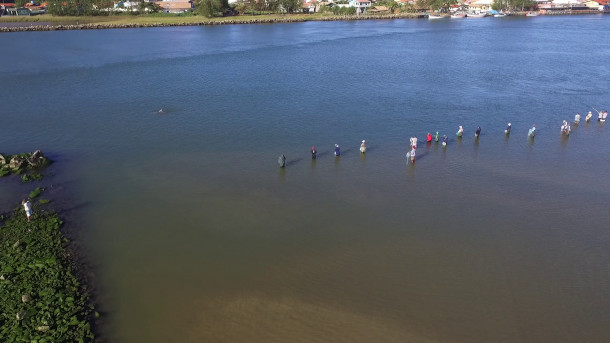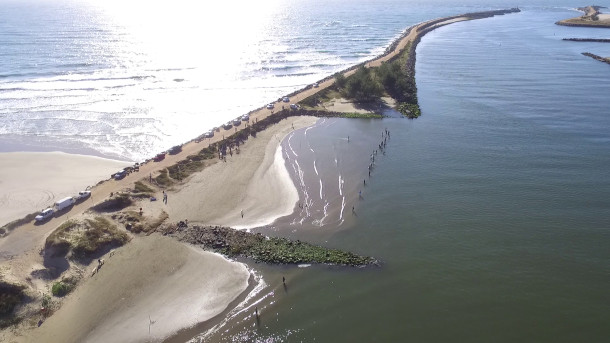Dolphins and People: Fishing Buddies
Air Date: Week of February 24, 2023
The dolphins corral migratory mullet fish toward the water’s edge, making it easier for the fishermen to catch fish. (Photo: Dr. Bianca Romeu, Departamento de Ecologia e Zoologia, Universidade Federal de Santa Catarina; Florianópolis, SC 88040-900, Brazil)
In the coastal community of Laguna, Brazil, many net-casting artisanal fishers have an unexpected fishing partner in dolphins. Fishers who work with dolphins catch a lot more fish and now scientists have figured out what the dolphins are getting out of it. Mauricio Cantor is an Assistant Professor of biology and behavioral ecology at Oregon State University and the lead author of the study. He joins host Bobby Bascomb.
Transcript
BASCOMB: In the coastal community of Laguna, Brazil, artisanal fishers make a living from casting their nets for migrating fish but they aren’t doing it alone. Many fishers have an unexpected fishing partner. Dolphins. Until recently, scientists weren’t sure what the dolphins were getting out of it. But research recently published in the Proceedings of the National Academy of Sciences appears to solve the mystery. For more, I’m joined now by Mauricio Cantor, an Assistant Professor of biology and behavioral ecology at Oregon State University and the lead author of the study. Mauricio, welcome to Living on Earth!
CANTOR: Thank you very much. Thanks for having me here.
BASCOMB: So what exactly does this cooperative hunting look like? You know, how do the dolphins and humans interact in this way?
CANTOR: So this cultural practice has been going on for over a century now. And only recently, we started to understand exactly how it works and what each species is gaining from this. So if you go to Laguna right now, you see probably a couple of artisanal fishers standing at the beach waiting for the dolphins to approach. They know that just by going to fish by themselves, then they're not going to get pretty much anything out of this. So when the dolphins approach to the coast, everybody runs into the water, and they can wait there until the dolphins kind of work the fish around, push them towards the coast. And then there's this very specific moment where the dolphin changes its behavior and does this signal that the fishers interpret as the right time and place to where they should cast their nets. And then the dolphins will dive and wait for more or less ten to fifteen seconds for the nets to close over the fish and then they will engage in their echolocation clicks, which suggests that they're really homing on the prey. And then after that, they will both part ways and hopefully with lots of fish.

The fishermen’s nets break up mullet schools, allowing dolphins to chase down stragglers and get their fill. (Photo: Alexandre Machado, Departamento de Ecologia e Zoologia, Universidade Federal de Santa Catarina; Florianópolis, SC 88040-900, Brazil)
BASCOMB: So it's easy to see what the humans are getting out of this. The dolphins are sort of corralling the fish towards their nets. But what are the dolphins getting here?
CANTOR: So since this interaction has been around for over 100 years, we would imagine that the dolphins are also gaining similar benefits. Otherwise, they would just do something else. So both predators, humans and dolphins, they have the same goal of catching fish, but they have different strategies. The fishers they want most of the school, so that's why they use their tools, their nets. But the dolphins can only catch one fish at a time. And those are big fish there, they can be over one kilo or 60 centimeters. And what we saw is that when the nets kind of trap the mullet school underwater, it makes it much easier for the dolphins to catch their fish as well.
BASCOMB: So is the idea here then that the majority of fish end up in the nets but there's a few stragglers outside the nets that are easier for the dolphins to catch, because they're not in a large school that's hard to navigate?
Fishermen are seventeen times more likely to catch fish when the dolphins are working with them. (Photo: Dr. Fábio G. Daura-Jorge, Departamento de Ecologia e Zoologia, Universidade Federal de Santa Catarina; Florianópolis, SC 88040-900, Brazil)
CANTOR: Exactly. So a fish school is actually a textbook example of anti-predator strategy. And this is true for these mullet fish, this primary target of this fishery. They migrate in these very large, fast moving fish schools. Similar to a flock of birds flying, they make those collective decisions really quick. And that makes it really difficult for the dolphins to catch. Now a fish outside of that school, it's an easy target for the dolphins. They can out swim them and they can catch really easy.
BASCOMB: And I understand you have some data that actually quantifies how much more successful the fisherman and the dolphins are. Can you tell us about that, please?
CANTOR: So by sitting at the beach and watching this for hours in 2018 and 19, we recorded over 4000 interactions like this. And then, you know by counting how much fish and how much biomass the humans get out of this, we estimated that they're 17 times more likely to catch any fish when the dolphins are working with them. And they tend to get up to four times more biomass of fish when the dolphins are working with them, compared to when there's no dolphins in the area.
BASCOMB: And I understand that the dolphins that partake in this interaction with humans are more likely to survive to adulthood. Is that right? Can you tell us about that?
The cooperative dolphins, or those that regularly engage with the fishermen, are thirteen times more likely to survive to adulthood compared to those dolphins that hunt on their own. (Photo: Dr. Carolina Bezamat, Departamento de Ecologia e Zoologia, Universidade Federal de Santa Catarina; Florianópolis, SC 88040-900, Brazil)
CANTOR: What we found from our modeling is that the dolphins that regularly cooperate with the artisanal fishers, what we call the cooperative dolphins, they're 13 percent more likely to survive to adulthood, compared to the other noncooperative dolphins, the ones that never engage in this cooperation with the net casting fishers. And there's a couple of reasons for this. We are yet to understand if the amount of food that they catch promotes their survival. But one thing that is much more clear right now is these cooperative dolphins, they spend a lot of their time interacting with these net casting fishers, and these kinds of net casting fisheries, they're pretty safe for the dolphins, so you'd have a low probability of being tangled in that net. Now the noncooperative dolphins, they will range over a much larger area to catch fish for themselves, and over this larger area they are exposed and often encounter other types of fisheries, including illegal fisheries, such as drift nets and trammel nets. They are set to kill anything that, you know, hits on them, including dolphins. So by not staying with the artisanal fishers, the noncooperative dolphins actually have this additional source of mortality.
BASCOMB: How close of a relationship is this with, you know, individual dolphins? Could the fishermen actually recognize and say, yeah, that's a dolphin I know, and this one's not going to give me the time of day?

This method of cooperative hunting has been part of Laguna’s culture for over 150 years. (Photo: Alexandre Machado, Departamento de Ecologia e Zoologia, Universidade Federal de Santa Catarina; Florianópolis, SC 88040-900, Brazilga)
CANTOR: Oh, yeah, absolutely. Actually, knowing who is who on the dolphin side is really key for the interaction to take place in the right form. So the experienced fishers can tell apart pretty much all the individual dolphins. They can tell them apart from different natural marks that they have on their dorsal fins on their body, but also the way they behave. They can clearly distinguish between what they call good dolphins, the cooperative ones, the ones that you know, regularly approach and interact with them but are also really skilled at bringing the fish, giving that behavior cue that they interpret as the right time to cast nets, all of this. So they know these good dolphins, where they are in the area, everybody runs into the water because it's almost guaranteed they will catch fish.
BASCOMB: Mauricio Cantor is an Assistant Professor of Biology and Behavioral Ecology at Oregon State University. Mauricio, thank you so much for your time today.
CANTOR: Thank you very much. It's been a pleasure talking to you.
Links
Living on Earth wants to hear from you!
Living on Earth
62 Calef Highway, Suite 212
Lee, NH 03861
Telephone: 617-287-4121
E-mail: comments@loe.org
Newsletter [Click here]
Donate to Living on Earth!
Living on Earth is an independent media program and relies entirely on contributions from listeners and institutions supporting public service. Please donate now to preserve an independent environmental voice.
NewsletterLiving on Earth offers a weekly delivery of the show's rundown to your mailbox. Sign up for our newsletter today!
 Sailors For The Sea: Be the change you want to sea.
Sailors For The Sea: Be the change you want to sea.
 The Grantham Foundation for the Protection of the Environment: Committed to protecting and improving the health of the global environment.
The Grantham Foundation for the Protection of the Environment: Committed to protecting and improving the health of the global environment.
 Contribute to Living on Earth and receive, as our gift to you, an archival print of one of Mark Seth Lender's extraordinary wildlife photographs. Follow the link to see Mark's current collection of photographs.
Contribute to Living on Earth and receive, as our gift to you, an archival print of one of Mark Seth Lender's extraordinary wildlife photographs. Follow the link to see Mark's current collection of photographs.
 Buy a signed copy of Mark Seth Lender's book Smeagull the Seagull & support Living on Earth
Buy a signed copy of Mark Seth Lender's book Smeagull the Seagull & support Living on Earth

